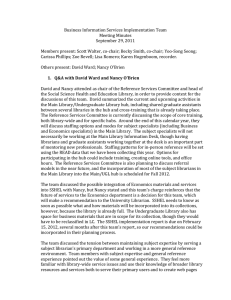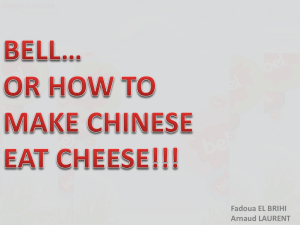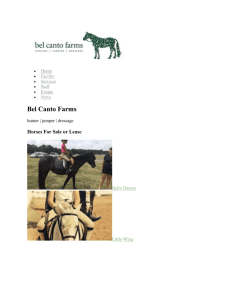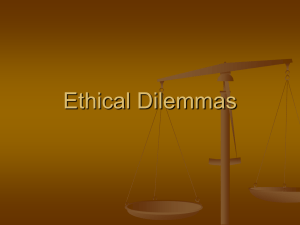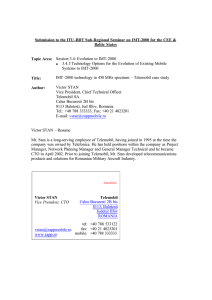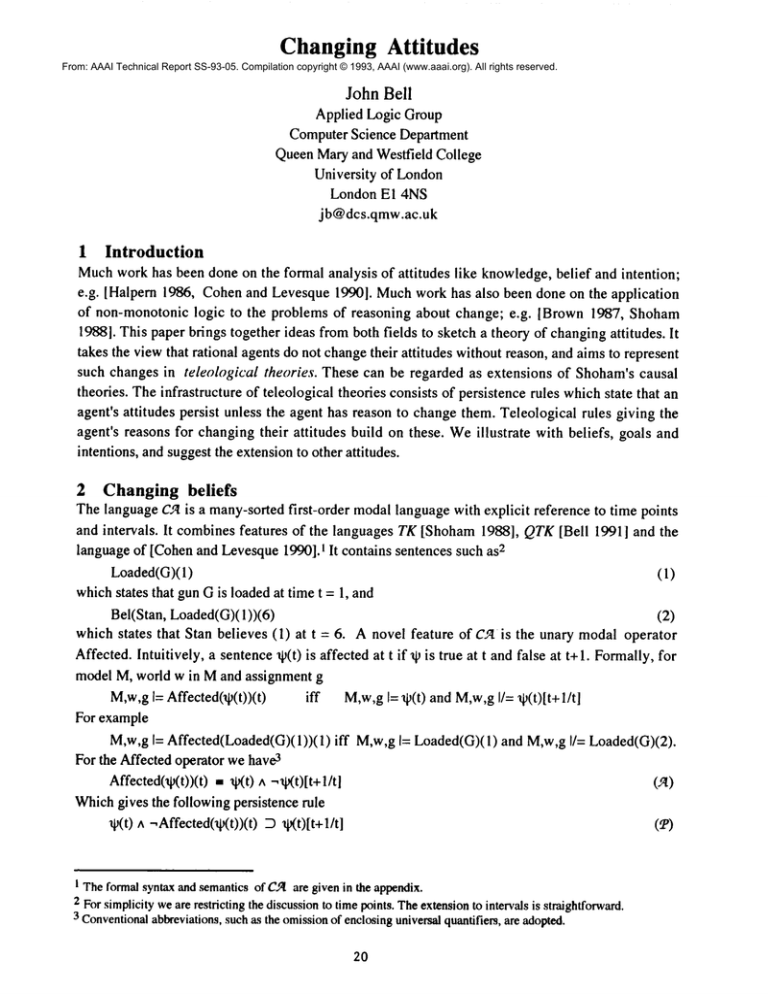
Changing Attitudes
From: AAAI Technical Report SS-93-05. Compilation copyright © 1993, AAAI (www.aaai.org). All rights reserved.
John Bell
Applied Logic Group
Computer Science Department
Queen Mary and Wesffield College
University of London
London E1 4NS
jb@dcs.qmw.ac.uk
1 Introduction
Muchwork has been done on the formal analysis of attitudes like knowledge, belief and intention;
e.g. [Halpern 1986, Cohen and Levesque 1990]. Much work has also been done on the application
of non-monotonic logic to the problems of reasoning about change; e.g. [Brown 1987, Shoham
1988]. This paper brings together ideas from both fields to sketch a theory of changing attitudes. It
takes the view that rational agents do not change their attitudes without reason, and aims to represent
such changes in teleological theories. These can be regarded as extensions of Shoham’s causal
theories. The infrastructure of teleological theories consists of persistence rules which state that an
agent’s attitudes persist unless the agent has reason to change them. Teleological rules giving the
agent’s reasons for changing their attitudes build on these. Weillustrate with beliefs, goals and
intentions, and suggest the extension to other attitudes.
2
Changing beliefs
The language CA is a many-sorted first-order
modal language with explicit
reference to time points
and intervals. It combines features of the languages TK [Shoham 1988], QTK[Bell 1991] and the
2language of [Cohen and Levesque 1990]. l It contains sentences such as
Loaded(G)(1)
which states that gun G is loaded at time t = 1, and
(1)
Bel(Stan, Loaded(G)(1 ))(6)
(2)
which states that Stan believes (1) at t = 6. A novel feature of CAis the unary modal operator
Affected. Intuitively, a sentence ap(t) is affected at t if ap is true at t and false at t+ 1. Formally, for
model M, world w in M and assignment g
M,w,gI= Affected0p(t))(t)
iff M,w,gI= ap(t) and M,w,gI/= ap(t)[t+
For example
M,w,g I= Affected(Loaded(G)( 1))(1) iff M,w,g l= Loaded(G)(1) and M,w,g I/= Loaded(G)(2).
3For the Affected operator we have
Affected(V(t))(t) " V(t) A -,V(t)[t+l/t]
Whichgives the following persistence rule
V(t) ^ --,Affected(V(t))(t)
(A)
(P)
~ V(t)[t+l/tl
I The formal syntax and ~manticsof CAare given in the appendix.
2 For simplicityweare restricting the discussionto timepoints. Theextensionto intervals is straightforward.
3 Conventional
abbreviations,suchas the omissionof enclosinguniversalquantifiers, are adopted.
2O
The belief in persistence
2.1
Wecan nowstate our first persistencerule, the belief in persistence. If an agent a believes that ~, is the
case at t, anda does not believe that ap is affected at t, then a shouldbelieve that ap continuesto be the
case at t+ 1. Wetherefore have
Bel(a,V(t))(t) ^ -,Bel(a, Affected(ap(t))(t))(t) ~ Bel(a,V(t))(t)[t+l/t]
For example,supposethat Stan believes that gun G is loaded at t = 1
Bel(Stan, Loaded(G)(1 ))(1)
Supposefurther that Stan does not believe that G is unloadedat t = 14
-,Bei(Stan, Affected(Loaded(G)(
1))(1
Then,by BP,Stan believes that Gis still loadedat t = 2
(BP)
(3)
(4)
Bel(Stan, Loaded(G)(2))(2)
(5)
Rules like BPareintended to be interpreted like Shoham’scausal rules; that is, they are intended to be
used from left to right only, to reason "forwards in time" from the antecedent to the consequent.
Typically also, we want to be able to infer the second premise of these rules non-monotonically.For
example,if Stan has no reason to believe that Gis unloadedbetweent = 1 and t = 2, then he should
not believe that it is. Consequentlyweare interested in the preferred modelsof theories containing
such rules : those in whichthe beliefs of agents are chronologically minimisedin someway. Byway
of illustration wegive a simple definition of a preference criterion for the belief fragmentof CA;more
complexcriteria are discussedin the sequel.
Definition Simple preference criterion for the belief fragment of CA. Let @be a theory of CA, and
let Mand M’be modelsof 0. ThenM< M’if there exists a time point to such that
¯ M’I= Bel(a,q~)(t) if MI= Bel(a,q~)(t) for any agent a, base sentenceq9 and time < to. 5
¯ M’I= Bel(a,q0)(t) and I/ = Bel(a,tp)(t) fo r some agent a,base sentence ¢p,and timepointt = to
Definition Mis a preferred modelof a theory O if Mis a modelof O and there is no modelM’of O
such that M’< M.
So muchfor what agents should believe about continuity. Whatshould agents believe about change?
Here it is a matter of supplyinga theory whichtells us whenthey believe that facts becomeaffected.
For example,suppose that we have the following STRIPS-like[Fikes and Nilsson 1971] action type
Does(a, Pickup(b,l))
P, D: On(b,I), Clear(b), Emptyhanded(a)
A: Holding(a,b), Clear(l)
Supposealso that, as in STRIPS,an agent a is able to performan action if its preconditions (labelled
P) are true whenthe action is attempted. Thecurrent world description is then updatedby adding the
facts in the add-list (labelled A)to it, andremovingthe facts in the delete-list (labelled D)fromit.
CA (6) becomes
4 For simplicity it is assumedthat, as in the Situation Calculus, that events are instantaneous and that they have their
effect at the next time point. The extension to compoundevents with duration is indicated in the appendix. Note
howeverthat, unlike the Situation Calculus, manyevents mayoccur at the same time.
5 A "base formula is a formula that does not contain the Bel or Goaloperators.
21
(On(b,l) A Clear(b) ^ Emptyhanded(a))(t)A Does(a, Pickup(b,l))(t)
(Holding(a,b) a Clear(l))(t+l) A (--,On(b,l) A -,Clear(b) a -,Emptyhanded(a))(t+l)
Thusif agent a believes (7) and the preconditionsof the Pickupaction at t and these are true at t and
knowinglyperformsthe action at t then a shouldbelieve the things in the add list at t+ 1 and shouldno
longer believe the things in the delete list at t+l. This solution provides a simple solution to the
doxastic frame problem which works well in simple domains. Howeverit invokes the doxastic
ramification problemin complexones: as the complexityof the domainincreases it quickly becomes
impractical to stipulate the effects of context-dependent actions. To avoid this, some of the
consequencesof actions should be inferred [Wilkins 1988, Bell 19901. As a simple illustration, the
negationsof the facts in the delete list canbe inferred.
(On(b,l) A Clear(b) A Emptyhanded(a))(t)A Does(a, Pickup(b,l))(t)
Affected((On(b,l) ^ Clear(b) ^ Emptyhanded(a))(t))(t) A(Holding(a,b)
(8)
(Holding(a,b)D-,On(b,l) ^ --, Clear(b))(t)
(9)
(Holding(a,b) D --,Emptyhanded(a))(t)
(10)
So if
(On(A,L) A Clear(A) A Emptyhanded(Stan))(1) a Does(Stan, Pickup(A,L))(1)
(11)
and
Bel(Stan, (8) ^ (9) ^ (10) A(1
(12)
it follows(in all preferred models)that
Bel(Stan, (Holding(Stan,A)aClear(L) ^ --,On(A,L) A -,Clear(A) a-,Emptyhanded(Stan))(2))(2)
(13)
In the full paper an extendedexampleis given of two agents co-operating to build a tower. Theyboth
havethe samebeliefs about the initial state and the operators, and are awareof each others actions.
Theexampleshowshowtheir beliefs changeas a result of their actions, and that they have the same
beliefs aboutthe final state.
2.2 The persistence of memory
Wenowconsider memories;that is, beliefs about the past and present. Note that as an instance of P
we have
Bel(a, ap(t))(t) A--,Affected(Bel(a,~p(t))(t))(t)DBel(a,
(14)
But this just says that an agent’s beliefs, like any other facts about the world, persist until they are
affected. Moreinterestingly, agents maychange their beliefs about the past in the light of new
evidence. However,agents should keep those beliefs about the past and present that they have no
reason to change
(t’ s t) ^ Bel(a,ap(t’))(t) ^ -,Bel(a, Affected(Bel(a,ap(t’))(t))(t))(t) DBel(a,ap(t’))(t+l)
For example,if Stan believes at t = 2 that block Awason block B at t = 1
Bel(Stan, On(A,B)(I))(2)
AndStan has no reason to doubtthis belief at t = 2
-,Bel(Stan, Affected(Bel(Stan, On(^,B)(1))(2))(2))(2)
(15)
(16)
then, by Pg,(, Stan continuesto believe it at t =
Bel(Stan, On(^,B)(1))(3)
in all preferred modelsof the theory.
(17)
22
Agent’s beliefs about the past can change. For example,Stan maycometo believe at t = 4 that A was
on C at t = 1
Bel(Stan, On(A,C)(1 ))(4)
(18)
and so, given
Bel(Stan, (On(b,ll) ^ 11 ,~ 12 ~ -,On(b,12))(t))(t) ^ Bel(Stan,
(19)
we have
Bei(Stan, -, On(A,B)(l))(4)
(20)
2.3 The persistence of expectation
Similarly, an agent can haveexpectationsabout the future, whichit is rational to continueto hold until
there is evidenceto the contrary
(t < t’) ABel(a,V(t’))(t) A", Bel(a, Affected(Bel(a,V(t’))(t))(t))(t) ) (T’E)
2.3 The persistence of belief
Combining~l,/’and ~ gives the general case:
Bel(a,V(t’))(t) A-, Bel(a, Affected(Bel(a,V(t’))(t))(t))(t)
3
Changing goals and intentions
It is possible to give a similar theory for goals whichis compatiblewith Cohenand Levesque’stheory
of intention. ThesentenceGoal(a,qc)(t) asserts that agent a has q~ as a goal at t. Intuitively, goals
desires whichthe agent believes are realisable and choses to pursue.
3.1 The goal of persistence
Anagent mayhave a goal whichis satisfied at t and have as a goal that, other things being equal, the
goal should persist. Cohenand Levesquerefer to goals of this kind as maintenancegoals (M-Goals).
For M-Goalswehave the goal of persistence
Goal(a,V(t))(t) A -,Goal(a, Affected(V(t))(t))(t) D Goal(a,V(t))(t)[t+l/t]
Toobtain the intendedinterpretation, the preferencecriterion definedearlier is extendedto goals.
Definition Simple preference criterion for CA. Let O be a theory of CA, and let Mand M’ be
modelsof O. ThenM< M’if there exists a time point to such that
¯ M’I= Bei(a,tp)(t) if MI= Bel(a,q~)(t) for any agent a, base sentenceq~ and time < to.
¯ M’I= Bel(a,q~)(t) and MI/= Bel(a,q~)(t) for someagent a, base sentenceq~, and time point
¯ M’I= Goal(a,q~)(t)if MI= Goal(a,q~)(t)for any agent a, base sentenceq~ and time < to.
¯ M’I= Goal(a,tp)(t) and MI/= Goal(a,q~)(t) for someagent a, base sentence %and time point
For exampleif Stan is happythat A is on L at t = 1
(21
Goal(Stan,On(A,L)(l))(
-,Goal(Stan,Affected(On(A,L)(
l )( 1
(22)
then we can use g’~/’ to conclude that Stan wants A on L at t = 2. Using g’P in conjunction with
teleological rules defining whenan agent’s goals are affected, meansthat the agent’s M-Goalspersist
23
as long as the agent wants them to. This approach thus compares favourably with more rigid
formulations such as
M-Goal(a,~,(t))(t)-- Goal(a,Vt’. t s t’ ~ ap(t’))(t)
(23)
whichclaims that M-Goalspersist forever.
3.2 The persistence of goals
By contrast an achievementgoal (A-Goal)is a goal that the agent believes is not currently true, but
wouldlike to be true
A-Goal(a,ap)(t)= Bel(a,-,ap(t))(t) ^ Goal(a,:It’. t< t’^ ap(t)[t’/tl)(t)
(24)
This definition follows that given by Cohenand Levesque.Theygo on to define persistent goals, and
to define intention as a kind of persistent goal. A persistent goal (P-Goal)of an agent a is an A-goal
whicha will not give up until a believes either that it has been achieved, or that it is impossibleto
achieve. As they point out, this leads to fanaticism; once an agent has adopteda P-Goalthe agent will
not be deterred. Consequently they give an extended definition of P-Goal which has a parameter
allowingthe specification of an agent’s reasons for adoptingthe goal. Theagent maythen additionally
abandona P-Goal whenone of these reasons for pursuing it no longer holds. The drawbackwith this
approach is that the agent’s reasons have to be stipulated in advance. This is similar to STRIPS
approachto reasoning about change, and is therefore subject to the ramification problem. A better
solution allows agents to reason about their goals and abandonthem whenit is no longer rational to
continue holding them.
This can be done by combininga theory of rational agencywith the following persistence rule
(t < t’) AGoal(a,ap(t’))(t) A--,Goal(a, Affected(Goal(a,ap(t’))(t))(t))(t)~ Goal(a,ap(t’))(t)[t+
(PG)
Whenan achievement goal persists until the agent decides to abandonit. For example, following
Cohenand Levesque,wecan define the intention to do an action as
IntendToDo(a,e)(t)- Goal(a, :It’> t. Bel(a, Does(a,e)(t’))(t’) A Does(a,e)(t’))(t)
Then,if Stan intends to pickupblockA at t = 1
lntendToDo(Stan, Pickup(A))(1)
(26)
that is,
Goal(Stan, :It’> 1. Bel(Stan, Does(Stan,Pickup(A))(t’))(t’) a Does(Stan,Pickup(A))(t’))(l)
(27)
and Stan has no reason to changehis mindat t = 1
(28)
--,Goal(Stan, Affected((27)(1))(1)
Then by PGwe can conclude that
Goal(Stan, :It’ > 2. Bel(Stan, Does(Stan,Pickup(A))(t’))(t’) ^ Does(Start, Pickup(A))(t’))(2)
(29)
and so we have
IntendToDo(Stan, Pickup(A))(2)
(30)
24
4 Changing obligations,
commitments, desires,
choices,
etc.
The theory is readily extended to other attitudes. For example, following [von Wright1951, Smiley
1963, Hanson 1965, Sanders 1989, Shoham1991] we can add various obligation or commitment
operators, and give persistence rules analogousto ~/’~; for them. Theaccompanying
teleological theory
should then imply that an agent’s commitments
persist while it is reasonable for the agent to hold
them; e.g. until they are met, or until they are over-ruled by moreimportant commitments,etc.
Similarly for obligations. A desire operator can also be addedtogether with rules analogousto ~’P and
P~’ to represent the desire for persistence and the persistence of desire [de Sousa1987]. (Unlike
goals, desires maybe inconsistent or impossible.) As a final example,a choice operator can be added
together with a P~’-like persistence rule. Goalscan then be defined as desires whichthe agent believes
to be realisable and chosesto pursure.
5 Future
work
A great deal remains to be done. The langauge will be extended as indicated above. To fill in the
outlines, detailed examplesof teleological theories will be added. Further investigation of preference
criteria is required. Problemsarise even whendealing exclusively with beliefs. For exampleagent a
maycometo believe ¢p at t+l on the basis of the belief that agent a’ does not believe Vat t, and
conversely; as happens in the Wise ManPuzzle. Wemaythen want to impose a credence order on
agents, or to define agent-specific preferencecriteria. It mayalso be that wecannotdefine a preference
criterion and have to resort to the moregeneral notion of a relevance criterion [Bell 1993]. Finally,
there is the question of implementation. This will be done by adopting the model-buildingapproach
suggested in IBell 1993] and extending its application from causal theories [Bell 1992] to (suitably
restricted) teleologicaltheories.
Appendix
The language
CA
This appendixcontains the formal details of CAas discussed in the first three sections of this paperl
AsSection 4 suggests, it is readily extendable.
A.I Syntax
Let:
¯ D, A, T and E be disjoint sets of constant symbols.
¯ VD,VA,V3", VI and VEbedisjoint sets of variable symbols.
¯ Fr be a set of function symbols, containing the symbols+, max, min.
¯ R be a set of relation symbols.
Definition Theset of regular terms, termD,is D1.3 VD.
Definition Theset of agent terms, termA,is A U V
A.
DefinitionTheset of time-point terms, term3., is the minimalset such that:
,.¯ TUVwCterml
¯ If f is an n-ary functionsymbolin FI’ andtl ..... tn CtermTthenf(tl .....
DefinitionTheset of interval terms, termi, is {It,f] I t,t’ E terrrh,} UVi.
25
tn) C term’r.
Definition The set of event terms, termE, is E U VE.
Definition CAis the minimalset of formulas such that:
¯ If t, t’ E termT then (t < t’) CA
.
¯ If ut .... ,Un E termDU termA,r ~ER is an n-ary relation symbol,and i E terml
then r(ul ..... Un)(i)
¯ If u,u’ ~ termDU termAand i C terml then (u = u’)(i) CA.
¯ If ap(i) CA
then Affected0p(i))(i) ~ CA.
¯ If e ~ termLand i E terml then Occurs(e)(i) CA
.
¯ If a ~ termA,e ~ termEand i E termi then Agent(a,e)(i) CA.
¯ If a E termA,q~ E CAand i ~ termI then Bel(a,qg)(i) CA
, and Goal(a,qg)(i)
¯ If% qY~ CAthen -,q~ ~ CAand (q9 v qY) CA.
¯ If S E/{D, A, T, I, E}, v C Vs, and q~ E CAthen 3vq~ E CA.
Intuitively a sentenceof the formap(i) meansthat Vis true at interval i. In particular, Affected(V(i))(i)
states that the truth of the formulaV(i) is affected duringthe interval i, Occurs(e)(i)asserts that event
occurs duringi, Agent(a,e)(i)asserts that a is an agent of event e at i (makinge an action), Bel(a,q~)(i)
asserts that a believesq~ at i, andGoal(a,qg)(i)asserts that q~ is a goal of a’s
Definition The symbols^, D, -- and V are defined in the usual way.
Definition Relations on points.
(h = t2) " -’(tl < t2) ^ --(t2 <
(tt s t2) " (tt < t2) v (q =
Definition Functions and relations on intervals.
[q,t2]+l "- [max(ti,t2)+l,max(tt,t2)+l]
[q,t2] < [t3,t4] - max(tl,t2) < min(t3,t4)
[h,t21 = [t3,t4l - min(h,t2) = min(t3,t4) ^ max(h,t2) = max(t3,t4)
i<i’ - (i<i’)v(i=i’)
[tl,t2l starts [t3,t41 ,, min(tl,t2) : min(t3,t4) ^ max(tl,t2) < max(t3,t4)
[tl,t2l ends [t3,t4] - min(tl,t2) > min(t3,t4) ^ max(tl,t2) = max(t3,t4)
[q,t21 meets [t3,t4l - max(tt,t2)+l = min(t3,t4)
[tl,t21contains [t3,t4] - min(t3,t4) > min(tl,t2) ^ max(t3,t4) < max(tl,t2)
Definition Let q~ be a formulaof CAand let i an i’ be interval terms. Thenq~[i’/i] is the result of
substituting i’ for all free occurrencesof i in q~; havingfirst taken appropriatemeasuresto avoid the
capture of variables.
Abbreviation conventions.
¯ Interval termsof the form[t,t] will usually be abbreviatedsimplyto t.
¯ Enclosinguniversal quantification is omitted. For example,Bel(a,q~)(i) DBel(a,qY)(i)
26
abbreviatesVaVi(Bel(a,qg)(i)DBel(a,q~’)(i)).
¯ Multiple occurrencesof the sameinterval term maybe eliminated whenthe result is
unambiguous.
For example,(ap v ap’)(i) abbreviatesap(i) v ap’(i), and Bel(a,ap)(i)
abbreviatesBel(a,ap(i))(i).
A.2 Semantics
Definition Let Mbe a structure (’/4/, D, A, E, ’7, rT , FT, I, R, Occurs,Agent, Bed, Goal, V) where
¯ W, D, A, E and Tare disjoint non-emptysets.
" r~- C_TxT.
¯ F,r is a set of functionsover ’7".
¯ 1= {It,t’! I t,t’~T}.
¯ R is a set of relations over D UA.
¯ Occurs C__ Wx Ex I.
¯ Agent C__ Wx AxEx I.
¯ Be(. Axl--, coo(WxW).
¯ Goal". A x I --, ~ (Wx ’14/).
¯ V= (VD,VA,VT,VE,VF, VR)is an interpretation function such that:
¯ Vs: S --- S for S (E {D, A, T, E, IT} and correspondingS E {D, A, T, E, F~,}.
¯ VR:Wx RxI-"R.
Then Mis a modelfor CAif the followingconditionsare satisfied:
¯ (T, r~r) is the integers.
¯ F, rmapsthe function symbols+, min and maxto the standard integer functions.
¯ (w,a,e,i) Agent only if (w,e,i) C Occurs.
¯ for eacha and i, Be/’(a,i) is serial, transitive and Euclidean.
¯ for eacha andi, Goa/’(a,i)is serial, andGoa/’(a,i)_c Bef(a,i).
Intuitively, Wisa set of possible worlds, Dis a set of ordinaryindividuals, Ais a set of agents, E is
a set of primitive event types, and T is a set of time points. Theworlds in Warethought of as total
possible world histories which share a common
flow of time (T, r~r). The multisets in 1 represent
intervals; so intervals are definedin termsof time points. For each agent a andinterval i, Bd(a,i) is the
accessibility relation for agent a’s beliefs at interval i, and Goa/’(a,i) is the accessibility relation for
agent a’s goals at i. Therequirementthat Goa/’(a,i) __c Bd(a,i) ensures that agents can only havegoals
which they believe to be possible. The definition of V allows the extension of relations to vary
betweenworlds and times but, for simplicity, keeps the denotation of constants fixed across worlds
and times.
Definition A variable assignmentis a function g = (gD, gA, gT, gl, gE) where
gs: Vs -" S for S E {D, A, T, I, E} and correspondingS ~ {D, A, ’T, I, E}.
Def’mitionLet V be an interpretation function and g be a variable assignment.Let S be an elementof
{D, A, T, I, E}. Thenthe term valuation function Vgis defined as follows:
¯ For 1: ~ S, Vg(x)= Vs0:).
¯ For1: ~ Vs, Vg(lc) = gs(’C).
27
¯ For 1: = ffut ..... un) E termT,Vg(’t;) = V~-,(f)(Vg(ul).... ,
¯ For 1: = It’,t"l ~ terml, Vg(’~)= [Vg(t’), Vg(t")l.
Definition A variable assignmentg satisfies a formulaq9 at a worldw in a modelM(M,w,gI= q~)
follows:
M,w,gI= t < t’
iff
(Vg(t),Vg(t’))
M,w,gI= r(ul ..... Un)(i)
iff (Vg(u l),...,Vg(un)) E VR(w,r,Vg(i))
M,w,gI= (Ul = u2)(i)
Vg(ul) is Vg(u2)
iff
M,w,gI= Affected0p(i))(i) iff M,w,gI= ap(i) and M,w,gI/= ap(i)[i+
M,w,gI= Occurs(e)(i)
iff
(w,Vg(e),Vg(i)) Occurs
M,w,gI= Agent(a,e)(i)
iff
(w,Vg(a),Vg(e),Vg(i))
M,w,gI= Bel(a,q~)(i)
iff
M,w’,g I= q~ for all (w,w’) Bed(Vg(a),Vg(i))
M,w,gI= Goal(a,q~)(i)
iff
M,w’,g I= q~ for all (w,w’) Goal(Vg(a),Vg(i))
M,w,g I= ~q~
iff
M,w,g I/= q~
M,w,gI= q~ v tp’
iff
M,w,g I= q~ or M,w,g I= qY
M,w,g I= 3vq~
iff
M,w,g’I= q~ for someg’ whichdiffers from g at most on v
Thenotions of truth of a sentence tp at a world w in a modelM(M,wI= q~), truth of q~ in a model
(MI= ¢p), andvalidity of q~ in a class of models(1= tp) are definedin the usual
Definition Action
Does(a,e)(i) - Occurs(e)(i) ^ Agent(a,e)(i)
Definition Knowledge
Knows(a,q~)(i)- Bel(a,q~)(i)
Definition Compoundevents, DynamicLogic [Harel 1979].
Occurs(el;e2)(i) - :li’, i"(i’ starts i ^ i" ends i ^ i’ meetsi" ^ Occurs(el)(i’) ^Occurs(e2)(i"))
Occurs(elle2)(i) a, Occurs(el)0) v Occurs(e2)(i)
Occurs(e*)(i)- -,::li’(i contains i’^ Occurs(e)(i’)) v Occurs(e+)(i)
Occurs(e+)(i) :li’(i’ starts i ^ Occurs(e)(i’) ^ (i’ ends i v =li"(i’ meetsi" ^ i" ends i ^ Occurs(e+)(i"))))
Occurs(.’hp(i))(i)- ap(i)
A.3 Logic
The conditions on each Be£(a,i) meanthat the modallogic of the belief operator is KD45[Chellas
1980]. For example, we have the following versions of the distribution axiom, the consistency
axiom,and the necessitation rule:
Bel(a,~)(i) ^ Bel(a,q~3 ~0’)(i) 3 Bel(a,~0’}(i)
Bel(a,q~)(i):9 -,Bel(a,-, q~)(i)
tp / Bel(a,q~)(i)
28
Theconditions on each Goal(a,i) meanthat the modallogic of the goal operator is KD.For example,
we have
Goal(a,q~)(i) ^ Goal(a,q~ D q~’)(i) ~ Goal(a,q~’)(i)
etc.
Proposition The logic consisting of the belief logic KD45,the goal logic KDtogether with A, BP,
~, GP and PGis consistent.
References
J. Bell (1990) Whythe frame problem is not a problem, AI Communications
3(1) 3-10.
J. Bell (1991) ExtendedCausal Theories, Artificial Intelligence 48 211-224.
J. Bell (1992) Model-basedcausal reasoning, manuscript.
J. Bell (1993) Pragmaticreasoning; a model-basedtheory, to appear in the proceedingsof the
Applied Logic Conference, Amsterdam1992.
F. Brown,ed. (1987) The frame problern in Artificial Intelligence, MorganKaufmann,San Mateo,
CA.
B. Chellas (1980) ModalLogic’, CambridgeUniversity Press.
P. Cohenand H. Levesque(1990) Intention is Choicewith Commitment,
Artificial Intelligence 42
213-261.
R. Fikes and N. Nilsson (1971) STRIPS:Anapproachto the application of theorem proving
problemsolving, Artificial Intelligence 2 (1971) 189-208.
J. Halpern, ed. (1986) Theoretical Aspects of Reasoning About Knowledge,MorganKaufmann,
San Mateo, CA.
W.H.Hanson(1965) Semantics for deontic logic, Logique et Analyse 8 177-190
D. Harei (1 979) First-Order DynamicLogic, Springer, Berlin.
K.E. Sanders (1989) A logic for emotions: a basis for reasoning about commonsense
psychological
knowledge,11 th Cognitive Science Societ~ Conference, LawrenceEarlbaum,N J, 357-363.
Y. Shoham(1988) Reasoning About Change, MITPress, Cambridge, MA.
Y. Shoham(1991) AGENT0
a simple agent language and its interpreter, AAAI-91704-709.
J.J. Smiley(1963) Relative necessity, Journal of SymbolicLogic 28 113-134.
R. de Sousa (1987) The Rationality of Emotion, MITPress, Cambridge, MA.
D. Wiikins (1988) Practical Planning, MorganKaufmann,San Mateo, CA.
G.H. yon Wright (1951)AnEssay in Modal Logic’, North-Holland, Amsterdam.
29

